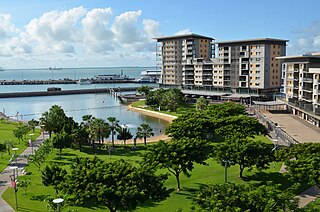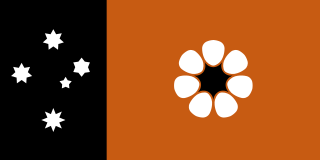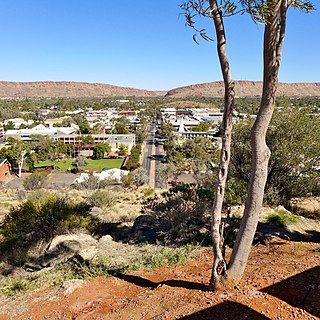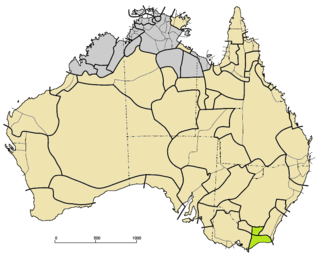
Darwin is the capital city of the Northern Territory, Australia. The city has nearly 53% of the Northern Territory's population, with 139,902 at the 2021 census. It is the smallest, wettest, and most northerly of the Australian capital cities and serves as the Top End's regional centre.

The Northern Territory is an Australian internal territory in the central and central-northern regions of Australia. The Northern Territory shares its borders with Western Australia to the west, South Australia to the south, and Queensland to the east. To the north, the Northern Territory looks out to the Timor Sea, the Arafura Sea and the Gulf of Carpentaria, including Western New Guinea and various other islands of the Indonesian archipelago.

Alice Springs is a town in the Northern Territory, Australia; it is the third-largest settlement after Darwin and Palmerston. The name Alice Springs was given by surveyor William Whitfield Mills after Alice, Lady Todd, wife of the telegraph pioneer Sir Charles Todd. Known colloquially as The Alice or simply Alice, the town is situated roughly in Australia's geographic centre. It is nearly equidistant from Adelaide and Darwin.
The Kimberley is the northernmost of the nine regions of Western Australia. It is bordered on the west by the Indian Ocean, on the north by the Timor Sea, on the south by the Great Sandy and Tanami deserts in the region of the Pilbara, and on the east by the Northern Territory.
Ngomburr, also spelt Ngumbur, is a supposed extinct Australian Aboriginal language. It has sometimes been assumed to be a dialect of Umbugarla, but it is effectively not attested; the only evidence to go on is that neighbouring peoples reported that it was similar to Umbugarla. It was spoken to the west of the South Alligator River, between the Ga'baarlgu and the South Alligator River, in Kakadu, Northern Territory.

Umbugarla or Mbukarla is a possible Australian language isolate once spoken by three people in Arnhem Land, northern Australia as of 1981, and is now extinct.
The Laragiya language, also spelt Larrakia, and also known as Gulumirrgin, is an Australian Aboriginal language spoken by just six people near the city of Darwin in northern Australia as of 1983. Only 14 people claimed to know the Laragiya language in 2016.
Lower Arrernte, also known as Lower Southern Arrernte, Lower Aranda, Lower Southern Aranda and Alenjerntarrpe, was an Arandic language. Lower Arrernte was spoken in the Finke River area, near the Overland Telegraph Line station at Charlotte Waters, just north of the border between South Australia and the Northern Territory, and in the Dalhousie area in S.A. It had been extinct since the last speaker died in 2011, but there is now a language revival project under way.

Sir Richard Owen was an English biologist, comparative anatomist and palaeontologist. Owen is generally considered to have been an outstanding naturalist with a remarkable gift for interpreting fossils.

The Yuin–Kuric languages are a group of mainly extinct Australian Aboriginal languages traditionally spoken in the south east of Australia. They belong in the Pama–Nyungan family. These languages are divided into the Yuin, Kuri, and Yora groups, although exact classifications vary between researchers. Yuin–Kuric languages were spoken by the original inhabitants of what are now the cities of Sydney and Canberra.
Umpila, also known as Ompeila, Ompela, Oom-billa, or Koko-umpilo, is an Aboriginal Australian language, or dialect cluster, of the Cape York Peninsula in northern Queensland. It is spoken by about 100 Aboriginal people, many of them elderly.
Limilngan, also known as Limil and Manidja, is an extinct Aboriginal Australian language of the Top End of Australia.
Wulna or Wuna is an extinct Indigenous language of Australia. It was a non-Pama-Nyungan language spoken in the Adelaide River region of the Northern Territory. It is poorly attested and only tentatively classified as being related to Limilngan.

The Gippsland languages are a family of Pama–Nyungan languages of Australia. They were spoken in the Gippsland region, the southernmost part of mainland Australia, on the Bass Strait. There are three rather distant branches; these are often considered single languages, though the dialects of Gaanay are sometimes counted separately:
Bindal is an extinct Australian Aboriginal language of North Queensland. The Bindal language region included the area from Cape Cleveland extending south towards Ayr and the mouth of the Burdekin River, encompassing the landscape within the boundaries of the Townsville City Council and Burdekin Shire Council.
The Marrku–Wurrugu languages are a possible language family of Australian Aboriginal languages spoken in the Cobourg Peninsula region of Western Arnhem Land. They are the recently extinct Marrgu, and the extinct Wurrugu. They were once classified as distant relatives of the other Iwaidjan languages, until Nicholas Evans found the evidence for Marrgu's membership insufficient, concluding that similarities were due to borrowing.
The Marrithiyal, also written Marrithiel, are an Aboriginal Australian people whose traditional territory lay 100 to 130 miles south of Darwin from Litchfield National Park and extend to the Daly River in the Northern Territory. They are also known as the Berringen people to represent their affiliation and deep connections across the neighbouring South Western Daly region.
The Limilngan, also known by the exonym Minitja and Buneidja, are an Aboriginal Australian people of the Northern Territory. Earlier ethnologists such as Norman Tindale referred to the group as Puneitja or variants of that spelling.








